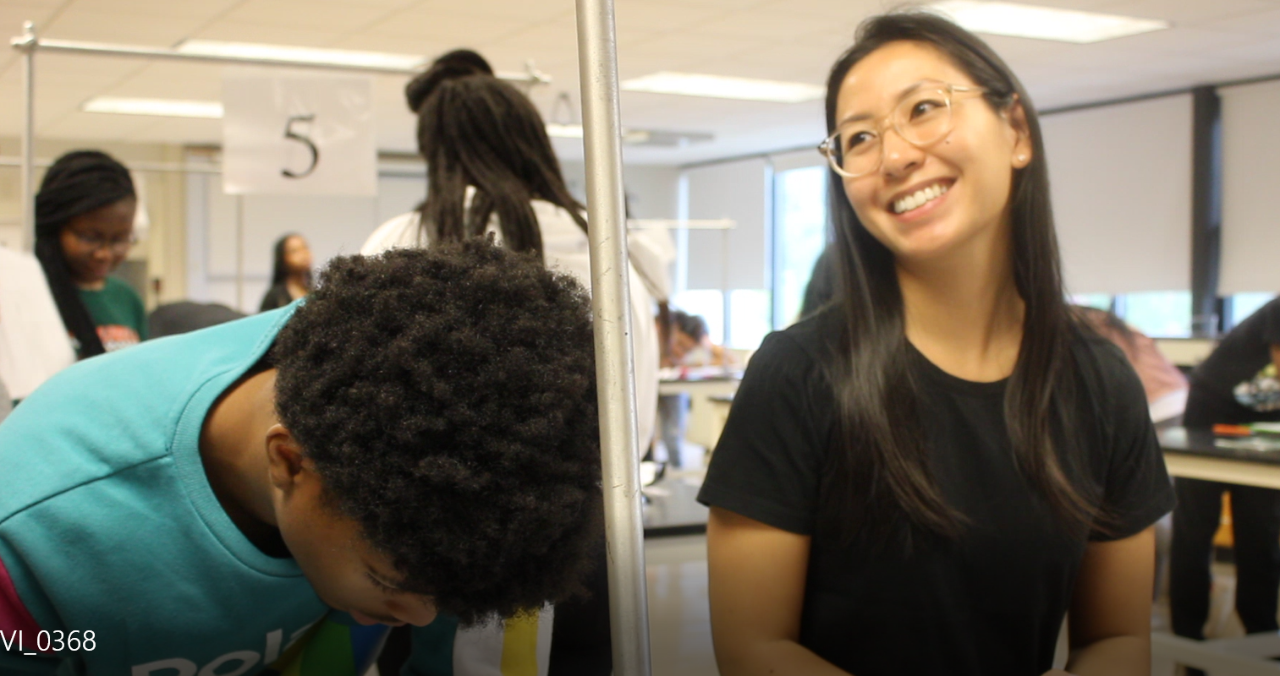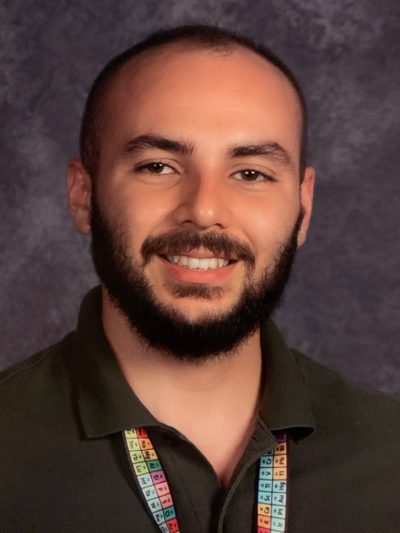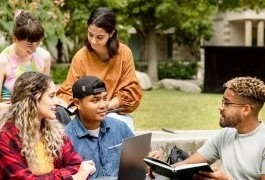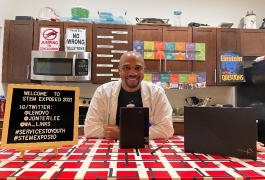Career Profiles: A Tale of Two High School Teachers
Did you know that U.S. high school teachers rate their lives better than members of all other professions except physicians? Or that there are many advancement opportunities with respect to salary and administrative roles? Plus, teachers have access to student loan forgiveness programs and scholarships. Just ask Melanie Yau, a teacher at Dr. Martin Luther King Junior College Preparatory High School in Chicago, IL, or Enrique Romero, a teacher at Montgomery High School in San Diego, CA.
Yau, who has been teaching for a decade, knew she wanted to help others but didn’t immediately know she wanted to teach. Her teaching experience began with forming study groups because she found she learned better when she taught concepts to a peer. Yau ended up becoming a chemistry teacher shortly after she graduated from college because she wanted young people to experience the fun and exciting nature of chemistry.
Romero thought of pursuing a career in chemical engineering. But after a series of outreach experiences with youth, he decided to follow his heart and has been in the classroom for five years. Yau and Romero took different paths but share an equal passion for teaching high school chemistry.
Here are their stories.
Melanie Yau

Describe your path to becoming a teacher.
I did not initially start my postsecondary education to become a teacher. I received a Bachelor’s of Science (BS) degree in chemistry from Marquette University, in Milwaukee, WI. Then I moved to Chicago and worked as an administrative assistant while I looked for what to do next. I found out about a 12-month program at the University of Illinois, Chicago, that is designed for those with a BS to get a teaching license and Master’s of Education and work in an urban setting. The major benefit of the program is that I could get a $10,000 Noyce scholarship if I committed to teaching in Chicago Public Schools for two years after completing the program. I was also eligible for the federal TEACH grants for the three semesters of the program, which helps pay for a degree if you teach for a certain period of time in a low-income area. During the orientation for the program, they informed us that we would qualify for the Public Service Loan Forgiveness Program. So the financial factor was a motivating factor. The program was intensive with coursework and observations. It prepared me for what the first year of teaching is really like and also for my National Board Certificate preparation.
What is the most important project you have worked on in your career?
Completing my National Board Certification. It was an intense year of teaching and working on a portfolio, but I found that watching videos of myself teaching and analyzing student work allowed me to see what I was and was not doing as a teacher. It also made me a better lesson planner because I make decisions based on who my students are and what they need, and it led to successful lessons.
What were your thoughts and concerns about salary and benefits as you explored teaching as a career?
I work in a school system with a salary schedule that compensates teachers for continuing education and years of teaching experience. So my decision to pursue National Board Certification and getting more graduate credits was made easier when I was ready to grow professionally.
What advice would you give an undergraduate who is considering becoming a STEM teacher?
Think about what type of school setting you intend on teaching in and volunteer in a classroom to observe. For example, I knew I wanted to work in Chicago Public Schools, where I graduated from. During my teaching program, I was able to observe classrooms in different high schools. My program was designed to prepare teachers for an urban setting, so I recommend you do some research about a teaching program’s specialties before you enroll.
What are your favorite and least favorite parts of being a teacher?
My favorite part about being a teacher is seeing students succeed. I also like that I can be an unapologetic nerd and take advantage of a lot of the teacher perks like free admission to museums. My least favorite part is the bureaucracy of working in a large school district. The red tape and lack of funding make it difficult to create experiences for students.
How do you balance your career and personal life?
I make sure to enjoy my weekends and my breaks. I try to schedule one professional development event to attend in the summer, but the rest of the summer I try not to think about school and enjoy my time with my dog Ella. My hobbies include going to hot yoga with my mom on my off days (and all summer!). I just started making sourdough bread with my own starter. I was on a tie-dye kick for a while and hosted a tie-dye party for my birthday last year. I like to read books on my Kindle and take naps!
What is your favorite concept to teach to students and why?
I’m excited to teach students concepts where they are explaining what is happening on a molecular level to describe a macroscopic observation. It’s exciting to see a concept “click” for a student when he/she is thinking through the explanation.
What can’t you live without in your classroom and why?
My class set of laminated periodic tables. Although I do need to replace them with periodic tables with the new element names! I’ve continued class when my projector went out and the electricity went out, but having those periodic tables means students don’t have an excuse for not learning during class time!

Enrique Romero
Describe your path to becoming a teacher.
My initial plan was to join the field of chemical engineering. I was very active in my undergraduate chemical engineering organization, planning outreach efforts with companies such as Schlumberger and Genentech. In truth, I enjoyed working with industry and exploring the ins and outs of what it means to be a scientist.
Over time I worked in a lab setting, preparing solutions, gathering data, and ensuring a chemically safe environment. But what hit me the most was the outreach efforts. I recalled my teaching experience and the countless opportunities offered through my science education minor at University of California, San Diego, (UCSD) and I missed providing a helping hand to the development of science curiosity in young minds. In my mind, I already knew my place in the world was to propagate science literacy and inquiry. I was good at it, but I resisted.
I finally reached out to one of my education professors at UCSD. They recognized my unique insight: I was raised in a Mexican immigrant family of eight. Although I was born in California, my ideals and perspective were heavily influenced by the philosophies of Latino culture. My sense of empathy is strong, and I suspect my education professors saw this as a benefit to the students that I would one day teach. I relate to the population and share their process of thinking from the perspective of low-socioeconomic-status youth.
The final push came from generous support provided by the ACS-Hach Scholarship and the The Robert Noyce Teacher Scholarship Program. The financial support encouraged me to give teaching a shot, and I’m glad I did.
What are your favorite and least favorite parts of being a teacher?
Undoubtedly, the exploration and elaborate pieces of the 5E lesson sequence. I cherish the progression students make as they discover scientific principles through exploration and find ways to express their ideas and findings through quantitative and qualitative elaboration. When students embrace the methodology of inquiry as a way of thinking and learning, they are successful. And when they share their learning with peers it provides intrinsic value to the student. My goal is to keep the momentum of rigorous scientific curiosity going, so hopefully they will choose a career in STEM. I wish we had smaller class sizes. It’s tough planning high-quality and productive lessons for a large class. I’m more effective with a small group of students. I’ve spent many nights planning how the class will progress, but over the years I’ve learned to like the process of planning.
What advice would you give an undergraduate who is considering becoming a STEM teacher?
Try it out. Many universities have programs to mentor students or reach out to local schools. Get a feel for the amazing work STEM teachers are currently doing. The curriculum has changed, and it requires students to think critically about concepts. Gone are the days of drill-and-kill, so students have a good experience learning science. And if you find yourself having a good time facilitating and assisting in a classroom, then make that final decision. Explore different schools and grade levels, and spend time with like-minded educators who enjoy science.
What surprises you the most in your career?
The apparent unlimited ability for students to reach higher potentials. No matter the student, I haven’t found one that I feel is not up to improving their scientific thinking. Both on the high end and low end, students will surprise you with their adaptability.
There are a lot of conversations about teacher salary and benefits—what were your thoughts/concerns about this as you explored the possibility of teaching as a career?
Salaries and benefits were a main concern when I chose this career. I wondered if I could sustain myself and a family in the future. Ultimately, the benefits are excellent, and the pay is supplemented by grants and other opportunities such as outreach grants for science teachers. Each year since becoming a teacher there have been opportunities for professional development that involve supplemental pay. They’re out there, just keep looking!
What is your favorite concept to teach to students and why?
That is a tough one to answer; it’s close between gases and electrochemistry. Gas concepts are relatable yet complex. Students interact with the chemistry of gases hands-on, which is an excellent way to get them to buy into the concepts more readily. Electrochemistry concepts seem like magic, as the students tell me. Reacting chemicals to generate electricity—what’s more fun than that?
What can’t you live without in your classroom and why?
My laptop cart! We incorporate plenty of science hardware (such as Vernier probes) that require the use of a computer. We collect high-quality data, which makes the quantitative analysis rich. I would be devastated without my science toys, as I call them.
How do you balance your career and personal life?
I keep a semi-strict schedule to stay centered. I try not to incorporate productivity with relaxation, and my method seems to work for my lifestyle. Making time for family is of utmost importance to me, which allows me to recharge after a long week. I’ve recently been traversing the world’s oceans. I took up diving as a hobby not too long ago. I have visited places such as French Polynesia, Indonesia, Japan, Mexico, Belize, and counting! My favorite part about this hobby is sharing my appreciation of the ocean with people from around the world.

As a STEM teacher, you can find a job nearly anywhere in the world. There are many advancement opportunities with respect to salary and administrative roles, and there are student loan forgiveness programs and scholarships for science teachers.
The average salary for midcareer teachers is between $60,000 and $100,000.
For more information on STEM teaching, check out Get the Facts Out, an NSF-funded collaboration project by the Colorado School of Mines, American Physical Society, American Chemical Society, American Association of Physics Teachers, and Mathematical Association of America.




